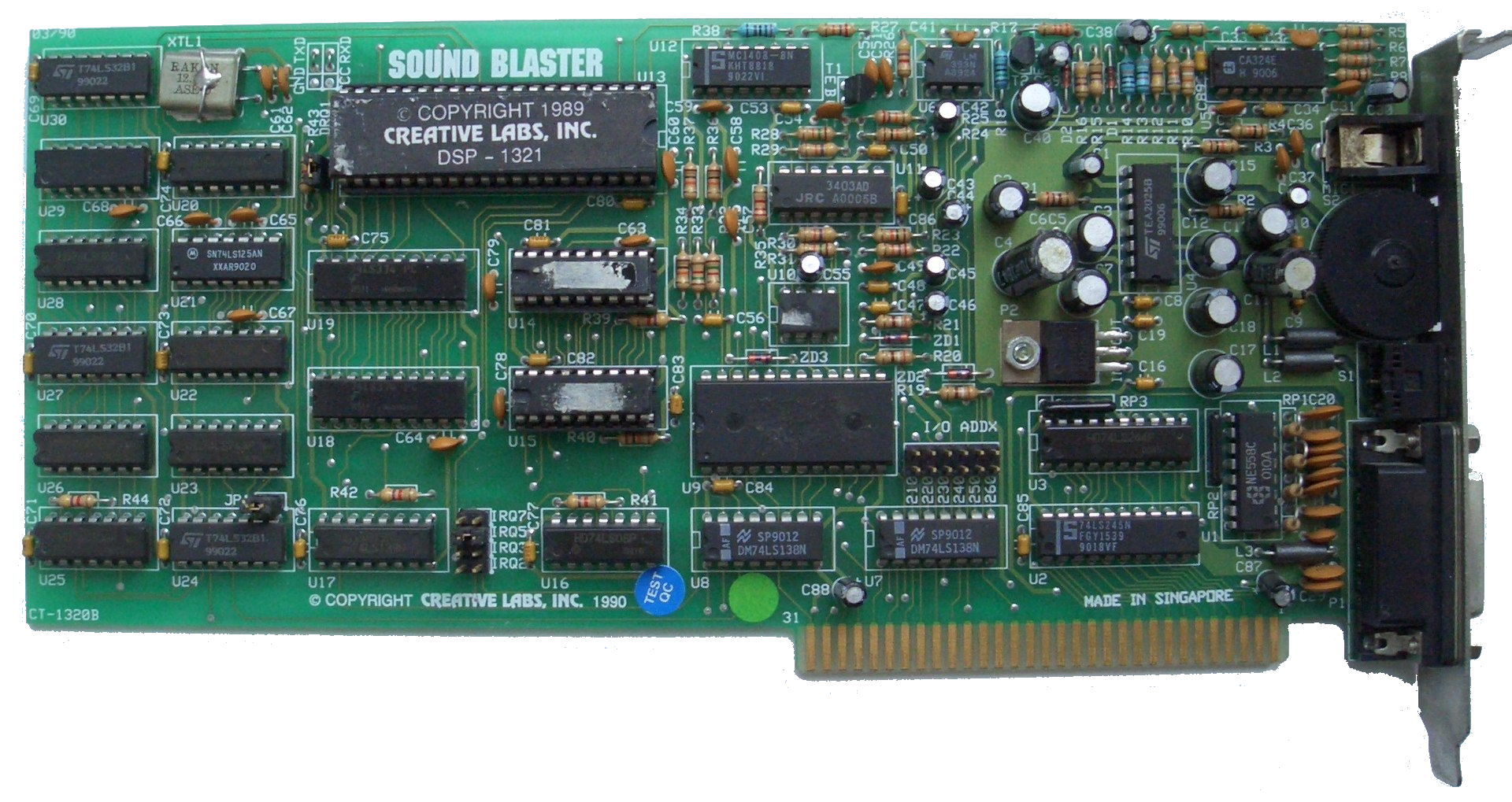Sound Blaster 1.0 / 1.5 (CT1310 and CT1320)
The original Sound Blaster v1.0 and v1.5 (CT1310, CT1320A/B) were released in 1989 as the successor to their Game Blaster. First announced in September 1988, the Sound Blaster had an 11-voice FM synthesizer which made use of the Yamaha YM3812 chip, often referred to simply as the OPL2 chip - this was the same chip used in the Ad Lib card, so it was 100% Ad Lib compatible.
|
Released | 1989 |
| Bus | ISA 8-bit | |
| FM Synth | Yamaha YM3812 | |
| Audio Codec | None | |
| Standards | Ad Lib, Sound Blaster | |
| Ports | Speaker-Out, Mic-In Game port Volume Thumbwheel |
|
| CD-ROM | None | |
| Wavetable | None | |
| Plug & Play | No | |
| FCC ID(s) | ||
| See Also | Sound Blaster 2.0 (CT1350) |
The original Sound Blaster was capable only of 8-bit mono 22 kHz playback, and could only record at 13 kHz.
CMS chips soldered on board gave backward-compatibility to Creative's earlier Game Blaster card, also known as the Creative Music System (CMS)
It was the first sound card on the market to have digital sample playback capability. The CT1310 is not known to actually exist as a model beyond Creative's literature. Its predecessor was the CT1300 which was the CMS/Game Blaster.
What made it different was the "DSP", or Digital Sound Processor, which is what Creative Labs called the "digital audio" part of the card. This brand new feature brought the ability to play back mono sampled sound at up to 22 kHz sampling frequency (about the same as FM radio quality, so quite poor by today's standards), and record at 12 kHz (which was similar to AM radio quality - even worse). In reality, this transformed DOS games, as this sampled sound was used to introduce sound effects into games while simultaneously playing music via the OPL2 (FM synthesis) chip. For backward compatibility with the earlier C/MS a.k.a. Game Blaster card, the C/MS chips [as they became known] were installed in sockets on the board.
Another key selling feature of the Sound Blaster was its inclusion of a game port. Back in these days, PC owners would need to spend around $50 to buy a game port adapter or a multi-I/O card that had a game port if they wanted to use a joystick with their PC. By adding this feature to the sound card, it freed up an expansion slot and at the very competivie price tag the Sound Blaster was being sold for, it was an easy decision for prospective sound card buyers.
The CT1320 is sometimes called "Sound Blaster 1.5". CMS chips were now socketed in order to be more economical for Creative Labs with CMS chips an optional add-on purchase. Sound Blaster 1.5 cards came with DSP version 2.00.
 The CT1320B (Sound Blaster 1.5) was a cost-cutting measure. Having recognised that CMS was unpopular, they made it a cost option by replacing the two CMS (Creative Music System/Game Blaster) chips with sockets - you could purchase the CMS chips direct from Creative for $29.95 if you wished to at a later time.
The CT1320B (Sound Blaster 1.5) was a cost-cutting measure. Having recognised that CMS was unpopular, they made it a cost option by replacing the two CMS (Creative Music System/Game Blaster) chips with sockets - you could purchase the CMS chips direct from Creative for $29.95 if you wished to at a later time.
In 1990, the CT1320C and CT1320U were launched which were also a Sound Blaster 1.5. Like the CT1320B, these models dropped the CMS chips by default but left the sockets in place - in all other ways these cards were similar to the Sound Blaster 1.0.
Board Revisions
Unlike later Creative Labs cards, their earliest cards did not have any board revision designation on the silkscreen.
Competition
The PC audio market was in its infancy back in 1989, with just the Ad Lib music synthesizer card for competition.
In the Media
Setting it Up
Downloads
Operation Manual Get in touch if you can provide this missing item! |
Original Utility Disks Get in touch if you can provide this missing item! |
Sound Blaster 1.x Drivers |
Sound Blaster 1.x Drivers |
Sound Blaster 1.x Drivers |
Sound Blaster 1.x Drivers |
